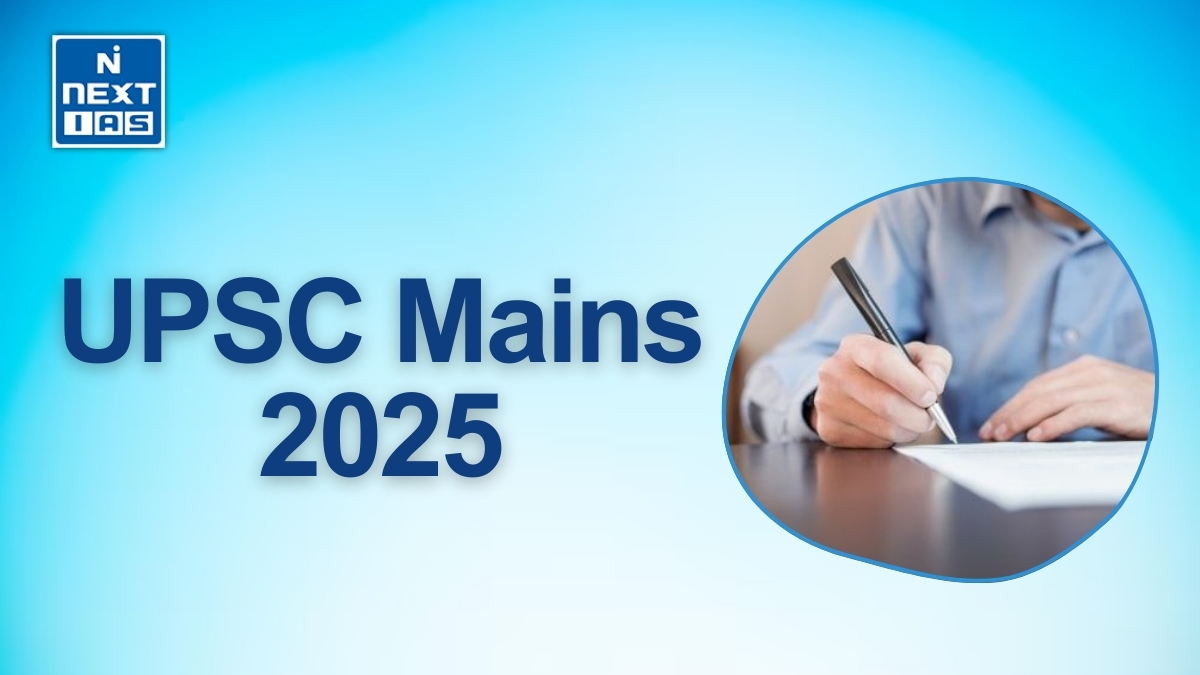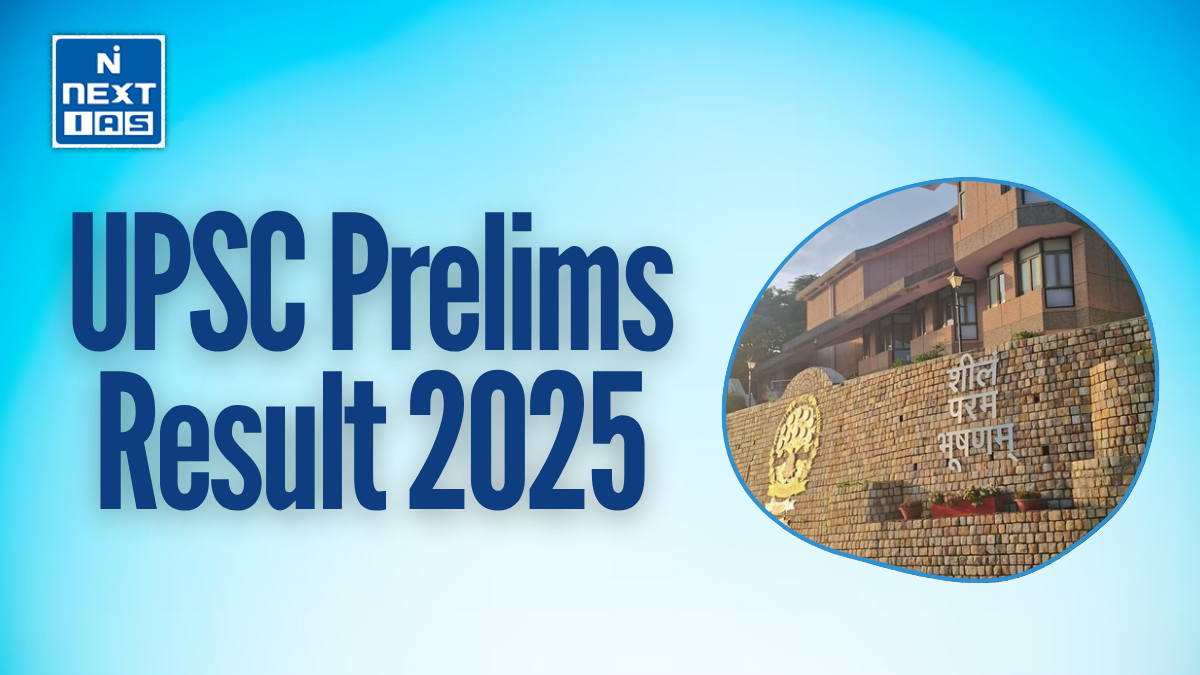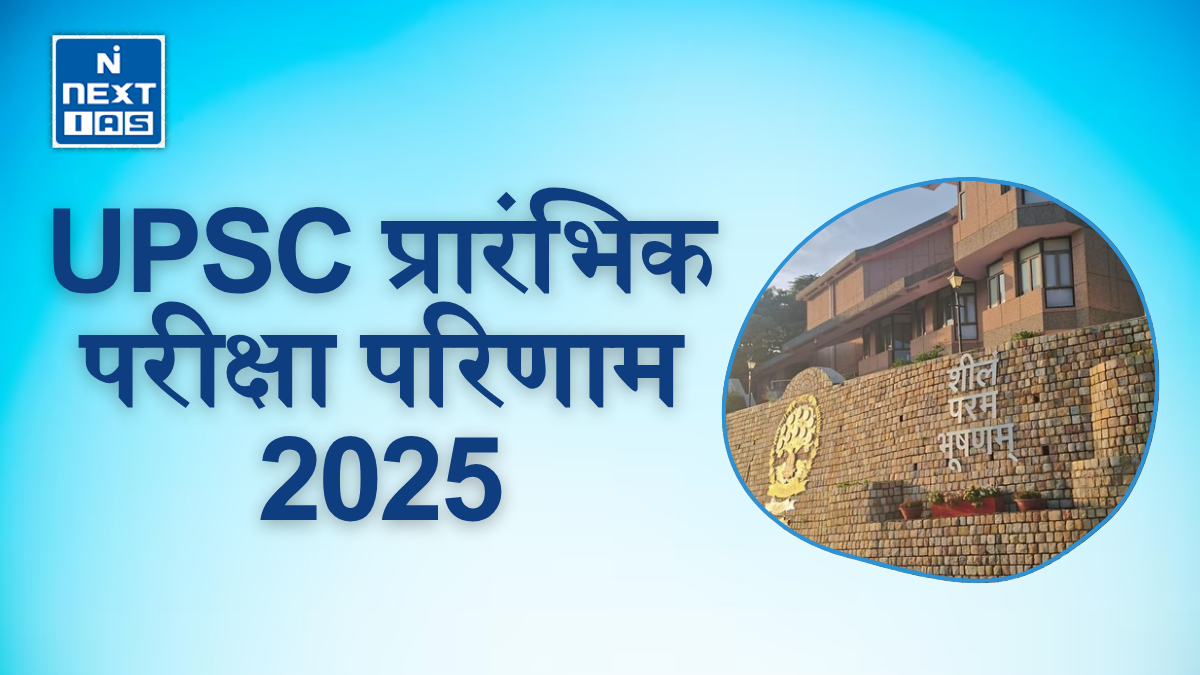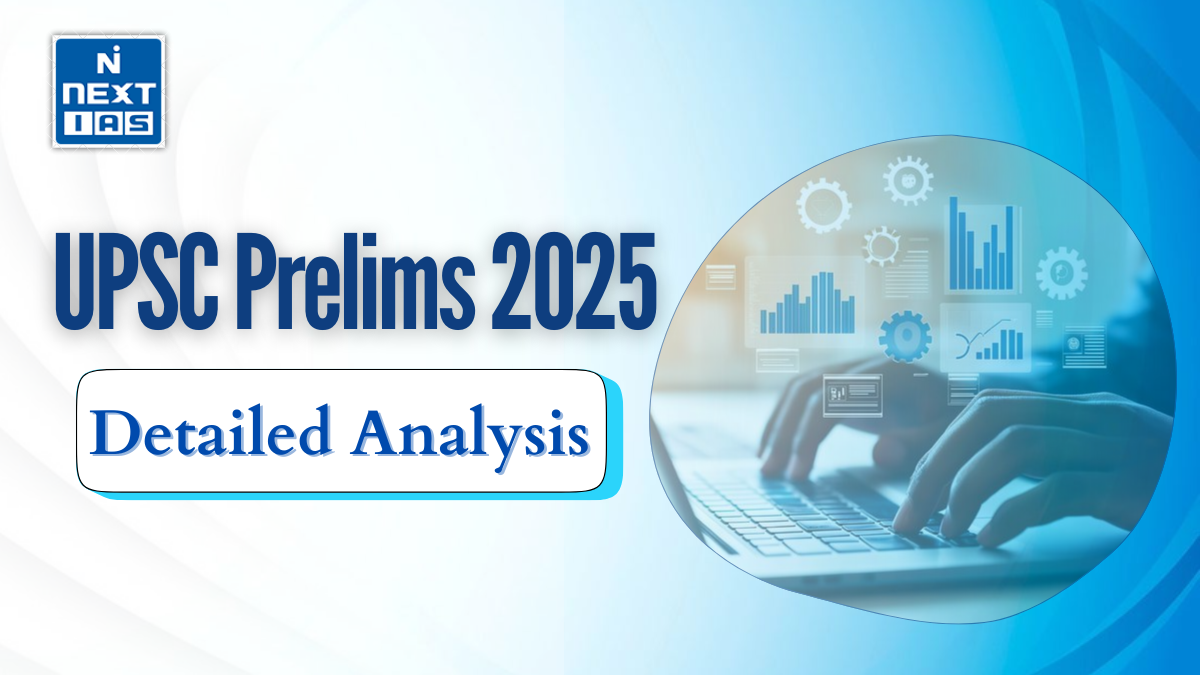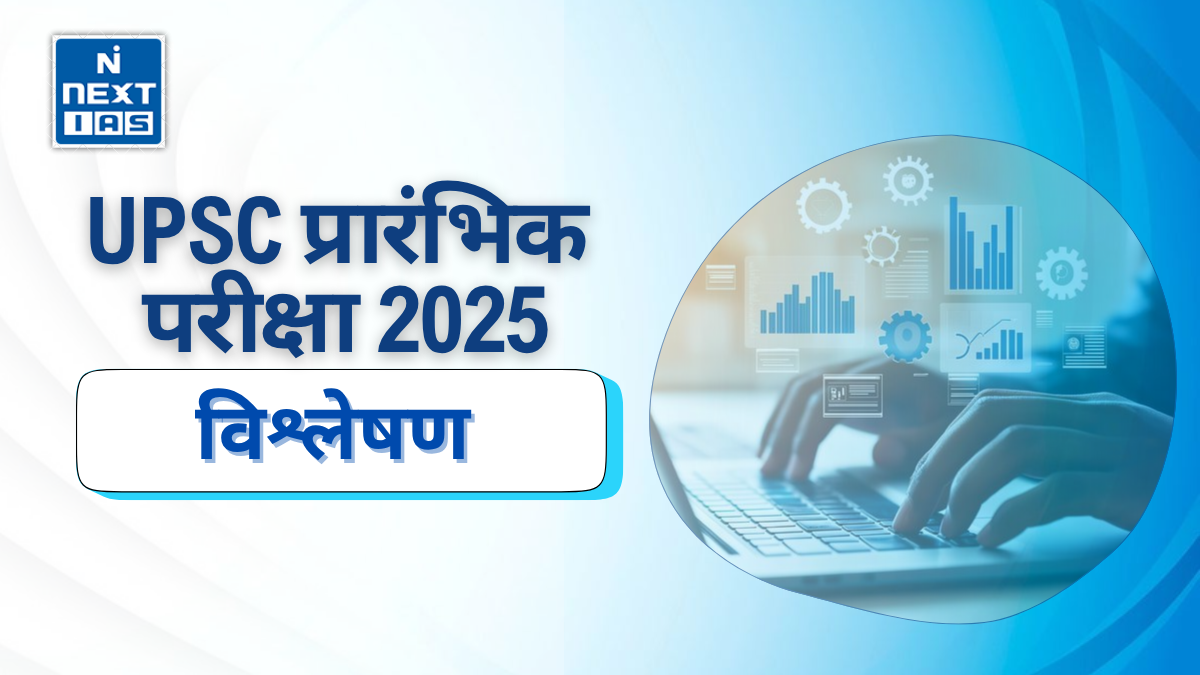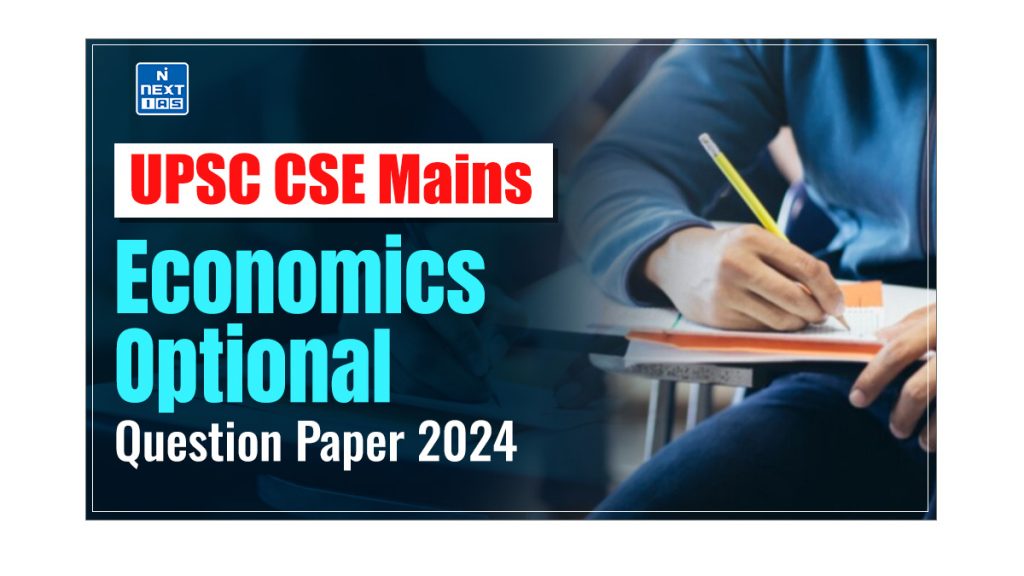
The UPSC conducted the CSE Mains 2024 Economics Optional Paper on September 29th, 2024, marking a significant milestone for aspirants. This examination assessed candidates’ knowledge and understanding of a diverse range of economic concepts, theories, and applications, encompassing macroeconomics, microeconomics, international economics, and the Indian economy. For future aspirants, analysing this year’s paper and identifying key trends is essential for thoroughly understanding the syllabus and adequate exam preparation.
| Exam Name | UPSC Civil Services Mains Exam 2024 |
| Total Optional Subjects in the UPSC CSE Exam | 48 subjects |
| UPSC Economics Optional Exam Date | September 29th, 2024 |
| UPSC Economics Optional Paper Duration | Economics Optional Paper-I (Morning Session – 9 AM to 12 PM) Economics Optional Paper-II (Afternoon Session – 2:30 PM to 5:30 PM) |
| Total Marks (Economics Optional) | 500 Marks (250 Marks Each) |
UPSC Mains 2024 Economics Optional Paper-I
खण्ड-A / SECTION-A
1. निम्नलिखित प्रत्येक प्रश्न का उत्तर लगभग 150 शब्दों में दीजिए:
Answer the following questions in about 150 words each: 10×5=50
(a) एक एकाधिकारात्मक प्रतियोगी बाज़ार में अनुभव किए गए माँग वक्र तथा आनुपातिक माँग वक्र में भेद कीजिए। समझाइए कि अनुभव किए गए माँग वक्र की तुलना में आनुपातिक माँग वक्र क्यों तीव्र ढलान वाला होता है। Differentiate between perceived demand curve and proportional demand curve in a monopolistic competitive market. Explain why the proportional demand curve is steeper than the perceived demand curve.
(b) प्रतिष्ठित विरोधाभास की घटना की आलोचनात्मक विवेचना कीजिए।
Discuss critically the phenomenon of classical dichotomy.
(c) सिद्ध कीजिए कि एक फर्म के दृष्टिकोण से समान स्तर की कर-आय को उत्पन्न करने हेतु विशिष्ट बिक्री कर की तुलना में मूल्यानुसार कर को अधिक प्राथमिकता दी जाती है।
Show that ad valorem tax is preferable to specific sales tax from a firm’s point of view in generating the same level of tax revenue.
(d) मुद्रा की पूर्ति को नियन्त्रित करने में राजकोषीय बिल की भूमिका का परीक्षण कीजिए।
Examine the role of treasury bills in controlling money supply.
(e) ब्याज के नव-प्रतिष्ठित ऋण-योग्य निधि सिद्धान्त की प्रमुख मान्यताओं का विवरण दीजिए।
Write down the major assumptions behind Neoclassical Loanable Funds Theory of Interest.
2. (a) उत्पादन में दो वस्तु-दो साधन-दो उत्पादकों के ढाँचे के अन्तर्गत पैरेटो इष्टतमता की शर्तों को व्युत्पन्न कीजिए। सिद्ध कीजिए कि पैरेटो इष्टतमता आवश्यक रूप से समानता का आश्वासन नहीं देती है।
Derive Pareto optimality conditions in production in a two commodities-two factors-two producers framework. Show that Pareto optimality does not necessarily guarantee for equity. (10+10=20 Marks)
(b) मार्शल और वालरस के बाज़ार की स्थिरता के दृष्टिकोण में प्रयुक्त व्यवहार-सम्बन्धी मान्यताओं को लिखिए। स्पष्ट कीजिए कि ये दोनों दृष्टिकोण उस समय परस्पर विरोधी हो जाते हैं जब माँग व पूर्ति दोनों वक्रों का ढाल सकारात्मक होता है।
Write down the behavioural assumptions used in Marshallian and Walrasian approaches of market stability. Show that these two approaches become conflicting when both the demand and supply curves are positively sloped. (8+7=15 Marks)
(c) एकाधिकारात्मक प्रतियोगिता के अन्तर्गत एक फर्म के अल्पकालीन व दीर्घकालीन सन्तुलन का वर्णन कीजिए।
Describe the short-run and long-run equilibrium of a firm under monopolistic competition. 15 Marks
3. (a) रेखाचित्र के उदाहरण से अल्प-रोजगार सन्तुलन की अवधारणा को समझाइए। कीन्स के दष्टिकोण से पूर्ण रोजगार को स्वतः क्यों नहीं प्राप्त किया जा सकता है? विश्लेषण कीजिए।
Explain the concept of underemployment equilibrium with graphics illustration. Why full employment cannot be reached automatically in Keynes’ approach? Analyse. (10+10=20 Marks)
(b) नीचे दी हुई सूचनाओं के आधार पर सन्तुलित राष्ट्रीय आय (४) तथा ब्याज दर (7) की गणना एक समुचित व्यापक आर्थिक मॉडल के उपयोग द्वारा कीजिए :
सकल बचत फलन : s = – 40 + 0.5(Y – T) + 0.25r
कर फलन T = 20 + 0 * 2Y
निवेश फलन: 120-0-25r
मुद्रा माँग फलन: L = 0.4Y – 0.5r
सकल मुद्रा पूर्ति M = 40 (करोड़ रुपये)
जब मुद्रा की पूर्ति को 20 करोड़ बढ़ाया जाएगा, तब सन्तुलन मूल्यों में किस प्रकार परिवर्तन होगा?
Calculate the equilibrium (national income (Y) and interest rate)(r) by using an appropriate macroeconomic model from the information given below:
Aggregate saving functions s = – 40 + 0.5(Y – T) + 0.25r
Tax function T = 20 + 0 * 2Y
Investment function: I=20-0-25r
Money demand function: L0-4Y-0-5
Aggregate money supply: M = 40 (rupees in crore)
How will the equilibrium values change when money supply is increased by 20 cores? (10+5=15 Marks)
(c) ब्याज के प्रतिष्ठित सिद्धान्त का आलोचनात्मक विश्लेषण कीजिए।
Critically analyse classical theory of interest. 15 Marks
4. (a) व्यापारिक बैंकों द्वारा साख सृजन के तन्त्र तथा गुणक प्रभाव पर इसके निहितार्थों का वर्णन कीजिए। कुछ सीमाओं का भी विश्लेषण कीजिए जो गुणक प्रभाव के निहितार्थों को हानि पहुँचा सकती हैं।
Describe the mechanism of credit creation by commercial banks and its implications on multiplier effect. Analyse some of the limitations that can jeopardise the implications on multiplier effect. (10+10=20 Marks)
(b) सार्वजनिक व निजी वस्तुओं में भेद कीजिए। सार्वजनिक वस्तुओं के सन्दर्भ में कैसे बाज़ार की असफलता उत्पन्न होती है, व्याख्या कीजिए।
Distinguish between public goods and private failure occurs in the case of public goods. Explain how market failure occurs in the case of public goods. (7+8=15 Marks)
(c) मुद्रा के परिमाण सिद्धान्त के अन्तर्गत फिशर के सिद्धान्त तथा केम्ब्रिज के नकद शेष दृष्टिकोण में क्या अन्तर है? प्रत्येक दृष्टिकोण की क्या आलोचना की गई है? वर्तमान सन्दर्भ में कौन-सा दृष्टिकोण अधिक प्रासंगिक है? औचित्य सिद्ध कीजिए।
What is the difference between Fisher’s theory and Cambridge cash balance approach to quantity theory of money? What is the criticism of each? Which one is more relevant in present context? Justify. (8+4+3=15 Marks)
खण्ड B
SECTION B
5. निम्नलिखित प्रत्येक प्रश्न का उत्तर लगभग 150 शब्दों में दीजिए:
Answer the following questions in about 150 words each: 10×5=50
(a) विकास के सन्दर्भ में ‘प्रति व्यक्ति’ जी० डी० पी० एक अपरिष्कृत सूचक है। आलोचनात्मक व्याख्या कीजिए।
Critically examine per capita’ GDP as a crude indicator of development.
(b) विनिमय दर के प्रबन्धित चल तथा निष्फल हस्तक्षेपों को समझाइए।
Explain managed floating and sterilized interventions for exchange rate.
(c) कार्बन व्यापार किस प्रकार पर्यावरण अवनयन को कम करने में सहायक होता है? विवेचना कीजिए। Discuss how carbon trading is helpful in reducing environmental degradation.
(d) “उच्च प्रशुल्क रोजगार में वृद्धि न करके मात्र बेरोजगारों का पुनर्वितरण करते हैं।” क्या आप इस कथन से सहमत हैं? समझाइए।
“Higher tariffs do not increase employment, they just redistribute the unemployed.” Do you agree with the statement? Explain.
(e) समझाइए कि किस प्रकार व्यापार के भागीदारों के लिए अर्पण वक्रों की सहायता से संतुलित व्यापार की शर्तें तय होती हैं।
Explain how the equilibrium terms of trade are determined by using offer curves of the trading partners.
6. (a) भुगतान शेष में समायोजन के लोच दृष्टिकोण तथा अवशोषण दृष्टिकोण का वर्णन कीजिए।
Discuss the elasticity approach and absorption approach for adjustments in balance of payments. 20 Marks
(b) स्टोलपर-सैम्युएलसन सिद्धान्त की सहायता से विकासशील देशों की आय की असमानताओं पर पड़ने वाले मुक्त व्यापार के सम्भावित प्रभावों की चर्चा कीजिए।
By using Stolper-Samuelson theorem, discuss the possible effects of free trade on income inequalities in developing countries. 15 Marks
(c) समझाइए कि किस प्रकार विदेशी विनिमय की माँग की लोच, आयातों की घरेलू माँग की लोच तथा आयात प्रतियोगी उत्पादों की घरेलू पूर्ति की लोच से प्रभावित होती है।
Explain how the elasticity of demand for foreign exchange is influenced by the elasticity of home demand for imports and by the elasticity of home supply of import-competing goods. 15 Marks
7. (a) समझाइए कि लेविस के आर्थिक विकास के सिद्धान्त के अनुसार आधिक्य श्रम द्वारा अर्थव्यवस्था में किस प्रकार संरचनात्मक रूपान्तरण होता है।
Explain how the structural transformation, in the economy, takes place with surplus labour as per Lewis theory of economic development. 20 Marks
(b) आर्थिक विकास में सार्वजनिक-निजी भागीदारी मॉडल के लाभ व हानियाँ क्या हैं? सार्वजनिक-निजी भागीदारी मॉडल की सफलता की मुख्य पूर्व आवश्यकताएँ क्या हैं? उदाहरण के साथ व्याख्या कीजिए।
What are the advantages and disadvantages of public-private partnership model for economic development? What are the key prerequisites for success of PPP model? Explain giving examples. (10+5=15 Marks)
(c) विकासशील देशों के लिए आयात प्रतिस्थापन तथा निर्यात संवर्धन की रणनीति के वाद-विवाद के मुद्दों (पक्ष-विपक्ष) की विवेचना कीजिए। आप किस रणनीति का समर्थन करेंगे और क्यों? समझाइए।
Discuss the issues (pros and cons) in the debate over import substitution and export promotion strategy for developing countries. Which strategy would you favour and why? Explain. (10+5=15 Marks)
8. (a) संयुक्त राष्ट्र विकास कार्यक्रम (यू० एन० डी० पी०) के मानव विकास सूचकांक (एच० डी० आइ०) के मुख्य अवयवों का वर्णन कीजिए। इस सूचकांक की प्राविधिक (क्रिया-पद्धति की) सीमाओं को लिखिए। इन सीमाओं को दूर करने के लिए उपयुक्त प्रविधि का सुझाव दीजिए।
Describe the major components used in Human Development Index (HDI) by the United Nations Development Programme (UNDP) Write down the methodological limitations of this index. Suggest appropriate method to eliminate these limitations. (10+5+5=20 Marks)
(b) असमानता व आर्थिक वृद्धि के मध्य सम्बन्ध का वर्णन करने के लिए कुज़नेट्स के उल्टे ‘U’ आकार के वक्र की परिकल्पना का वर्णन कीजिए। विकासशील देशों के लिए यह परिकल्पना किस प्रकार लाभकारी है?
Discuss the inverted ‘U’ shaped hypothesis by Kuznets in describing the relationship between inequality and economic growth. How is this hypothesis useful for developing countries? (10+5=15 Marks)
(c) विकास की अपेक्षित दर तथा प्राकृतिक दर में अन्तर कीजिए। समझाइए कि किस प्रकार हैरोड के आर्थिक वृद्धि के मॉडल में चाकू की धार अस्थिरता की समस्या उत्पन्न होती है।
Distinguish between warranted rate of growth and natural rate of growth. Explain how knife-edge instability problem occurs in Harrod’s model of economic growth. (10+5=15 Marks)
UPSC Mains 2024 Economics Optional Paper-II
खण्ड-A / SECTION-A
1. निम्नलिखित में से प्रत्येक प्रश्न का उत्तर लगभग 150 शब्दों में लिखिए :
Answer the following questions in about 150 words each: 10×5=50
1. (a) दादाभाई नौरोजी द्वारा विचारित भारत से ‘आर्थिक निकास’ (Economic Drain) की अवधारणा में सम्मिलित मदों का उल्लेख कीजिए ।
Mention the items of ‘Economic Drain’ from India as conceived by Dadabhai Naoroji. 10 Marks
1. (b) विवेचना कीजिए कि ईस्ट इंडिया कम्पनी के द्वारा विकसित रेलवे व्यवस्था क्यों भारत के हितों के विरुद्ध गयी ।
Discuss why the railway system developed by the East India Company went against the Indian interest. 10 Marks
1. (c) विवेचना कीजिए कि स्वतन्त्रता-पूर्व भारत में अहस्तक्षेप नीति भारत के लिए क्यों अच्छी नहीं थी।
Discuss why ‘Laissez Faire’ was not good for India during the pre-independence India. 10 Marks
1. (d) वर्णन कीजिए कि स्वतंत्रता-पूर्व भारत में कृषि के वाणिज्यीकरण से किसानों को क्यों अल्प लाभ ही प्राप्त हुआ ।
Describe why farmers derived little benefits from the commercialisation of agriculture in pre-independence India. 10 Marks
1. (e) “पी. एम. किसान-सम्मान निधि” योजना के क्या निहितार्थ हैं?
What are the implications of “PM-Kisan Samman Nidhi” scheme? 10 Marks
2. (a) भारत में बेरोजगारी की समस्या के निराकरण हेतु सरकार ने किन योजनाओं को शुरू किया है ? यह समस्या अभी भी क्यों बनी हुई है ?
What schemes are launched by the Government to deal with the problem of unemployment in India? Why the problem still persists? 20 Marks
2. (b) विकास की महालनोबिस रणनीति का क्यों परित्याग कर दिया गया ? इस रणनीति की क्या अपर्याप्तताएं थीं ?
Why the Mahalanobis strategy of development was abandoned? What were its inadequacies? 15 Marks
2. (c) भारत में स्वतंत्रता-पूर्व, जूट उद्योग द्वारा सामना किये गये समस्याओं को समझाइए । देश के बँटवारे के पश्चात यह समस्या क्यों और गम्भीर हो गयी ?
Explain the problems faced by the Jute industry during pre-independence India. Why the problem aggravated after partition of the country? 15 Marks
3. (a) भारतीय अर्थव्यवस्था में एम एस एम इ (सूक्ष्म, लघु, मध्यम उद्यमों) की भूमिका पर प्रकाश डालिए। इसके योगदान को बढ़ाने के लिए सरकार ने कौन से कदम उठाये हैं?
Highlight the role of MSMEs in Indian Economy. What steps have been taken by the Government to enhance its contribution? 20 Marks
3. (b) वर्ष 1950 से 1980 के दौरान भारत में राष्ट्रीय आय की वृद्धि-दर की प्रवृत्ति तथा इसका गरीबी पर पड़ने वाले प्रभाव की विवेचना कीजिए ।
Describe the trend in the growth rate of national income in India from 1950 to 1980 and its impact on poverty. 15 Marks
3. (c) उदारीकरण से पूर्व भारत में औद्योगीकरण की प्रकिया में अपर्याप्तताओं का वर्णन कीजिए ।
Discuss the inadequacies in the process of industrialisation in the pre-liberalised India. 15 Marks
4. (a) उदारीकरण के उपरान्त, भारत सरकार द्वारा राजकोषीय नीति में किए गए परिवर्तनों की व्याख्या कीजिए। किस सीमा तक ये परिवर्तन देश में सामाजिक न्याय के साथ संवृद्धि में सहायक सिद्ध हुए हैं ? विवेचना कीजिए ।
Discuss the changes made by the Government of India in the fiscal policy since liberalisation. How far these changes proved to be conducive to growth with social justice in the country? Discuss. 20 Marks
4. (b) भारत में किसानों की आय में तीव्रतर वृद्धि हेतु क्या उनको निगमित क्षेत्र से जोड़ा जाना आवश्यक है ? विवेचना कीजिए ।
For faster increase in farmers’ income, is it necessary to link them with corporate -sector in India? Discuss. 15 Marks
4.(c) ‘ट्रिम्स’ की प्रमुख विशेषतायें क्या हैं? यह किस प्रकार भारत के हितों के विरुद्ध कार्य करता है ?
What are the main features of ‘TRIMS’? How does it act against India’s interest? 15 Marks
खण्ड B
SECTION B
5. निम्नलिखित में से प्रत्येक प्रश्न का उत्तर लगभग 150 शब्दों में लिखिए :
Answer the following questions in about 150 words each: 10×5=50
5. (a) सी. एन. वकील द्वारा नियोजन के वैकल्पिक प्रारूप (model) का परीक्षण कीजिए ।
Examine the alternative model of planning given by C. N. Vakil. 10 Marks
5. (b) क्या भारत में सेवा-आधारित विकास पोषणीय है ? टिप्पणी कीजिए ।
Is service-led growth in India sustainable? Comment. 10 Marks
5. (c) रुपये के मूल्य में गिरावट से भारतीय अर्थव्यवस्था के लिए क्या निहितार्थ है ?
What are the implications of depreciating Rupee on Indian Economy? 10 Marks
5. (d) भारत के बहु-ब्रांड खुदरा क्षेत्र में एफ.डी.आई. (प्रत्यक्ष विदेशी निवेश) पर टिप्पणी कीजिए ।
Comment on FDI in Multi-brand Retail sector in India. 10 Marks
5. (e) क्या गरीबी ‘क्षमता-वंचन’ है? विवेचना कीजिए ।
Is poverty ‘capability deprivation’? Discuss. 10 Marks
6. (a) देश में विदेशी निवेश के सन्दर्भ में भारत सरकार की नीति का मूल्यांकन कीजिए। क्या आप महसूस करते हैं कि उनके क्रिया-कलापों को नियन्त्रित करने की आवश्यकता है ?
Evaluate the policy of Government of India with regard to foreign investment in the country. Do you feel that there is a need for control of their activities? 20 Marks
6. (b) विगत दस वर्षों में निर्यातों में वृद्धि हेतु भारत सरकार द्वारा कौन से कदम उठाए गए हैं ? क्या इनसे वांछित परिणाम प्राप्त हुए ? परीक्षण कीजिए ।
What steps have been taken by the Government of India to increase exports during the last 10 years? Have these yielded the desired result? Examine. 15 Marks
6. (c) भारत में द्वितीय हरित क्रांति का पक्ष-समर्थन क्यों किया गया ? इस संदर्भ में राष्ट्रीय कृषक आयोग की संस्तुतिओं का उल्लेख कीजिए ।
Why second green revolution was advocated for India? Mention the recom- mendation of the National Commission for Farmers in this regard. 15 Marks
7. (a) राजकोषीय संघवाद, राजकोषीय समेकन तथा सहकारी संघवाद में भेद कीजिए। भारत में सहकारी संघवाद की उपलब्धियों पर टिप्पणी कीजिए ।
Distinguish between fiscal federalism, fiscal consolidation and cooperative federalism. Comment on the outcome of cooperative federalism in India. 20 Marks
7. (b) भारत में उदारीकरण के उपरान्त, क्या कृषि में महिलाओं की भूमिका बदल गई है? टिप्पणी कीजिए ।
Whether the role of women in agriculture has changed after liberalisation in India? Comment. 15 Marks
7. (c) भारत में ग्रामीण निर्धनता के विभिन्न अनुमानों को समझाइये। इसको कम करने हेतु, सरकार द्वारा कौन से उपाय अपनाये गए हैं ?
Explain the various estimates of rural poverty in India. What measures have been adopted by the Government to reduce it? 15 Marks
8. (a) विगत पाँच वर्षों में, आर.बी.आई. द्वारा अपनायी गई मौद्रिक नीति के प्रमुख उद्देश्य क्या हैं ? इस अवधि में निवेश को प्रोत्साहन देने तथा कीमत-स्थिरता को बनाए रखने हेतु उठाए गए कदमों की विवेचना कीजिए ।
What are the main objectives of monetary policy adopted by the R.B.I. during last 5 years? Discuss the steps taken by the R.B.I. to encourage investment and maintain price-stability during this period. 20 Marks
8. (b) कृषि-साख प्रदान करने में संस्थागत वित्त में व्यापक प्रसार के बावजूद गैर-संस्थागत स्रोतों का योगदान सर्वाधिक क्यों हैं?
Why in spite of massive expansion of institutional finance, contribution of non- institutional sources in providing agricultural credit is still predominant? 15 Marks
8. (c) भारत में कृषि क्षेत्र को प्राप्त होने वाले विभिन्न प्रकार के अनुदान कौन से हैं? इनका क्या औचित्य है ?
What are the various forms of subsidies that go into agriculture sector in India? What is the justification for these? 15Marks
UPSC Mains 2024 Economics Optional Papers PDF
The UPSC Civil Services Mains 2024 Economics Optional Paper has been conducted, and the Question Paper PDF is now available. This question paper offers a detailed collection of questions, serving as an essential resource for understanding the specific requirements of the Economics optional subject. Aspirants can review the Economics question paper to evaluate the topics and difficulty level of the questions, providing valuable insights into the expectations of the exam. The link to download the PDF of the UPSC Mains 2024 Economics Optional question paper is provided below for easy access.
How to download the UPSC Civil Services Mains 2024 Economics Optional Papers?
To download the UPSC Civil Services Mains 2024 Economics Optional Papers, follow these steps:
- Visit the Official UPSC Website: Go to the official website of the Union Public Service Commission at upsc.gov.in.
- Navigate to the Examination Section: Look for the ‘Examinations’ tab in the main menu and click on it.
- Select ‘Previous Year Papers’: Within the Examinations section, find the link for ‘Previous Year Papers’ papers.
- Locate the 2024 Mains Examination Papers: Look for the section dedicated to the 2024 Civil Services Mains Examination.
- Find the Economics Optional Paper: Scroll through the list of available papers to locate the Economics Optional Paper.
- Download the PDF: Click on the link for the Economics Optional Paper to open it. Then, you can download the PDF file by clicking the download icon or using the ‘Save As’ option from your browser.
- Save for Reference: Once downloaded, save the document in a folder for easy access and future reference.
UPSC Mains Optional Previous Year Question Papers
| Geography Optional Papers | Download Now |
| PSIR Optional Papers | Download Now |
| Sociology Optional Papers | Download Now |
| Anthropology Optional Papers | Download Now |
| History Optional Papers | Download Now |
| Economics Optional Papers | Download Now |
| Mathematics Optional Papers | Download Now |
| Civil Engineering Optional Papers | Download Now |
| Electrical Engineering Optional Papers | Download Now |
| Mechanical Engineering Optional Papers | Download Now |
The UPSC Mains 2024 Economics Optional Paper has provided aspirants with a crucial resource to understand the exam’s requirements and develop effective strategies for future preparations. Stay tuned for more updates and insights on the UPSC Mains Optional examination, and download the Economics Optional question paper using the link provided.
